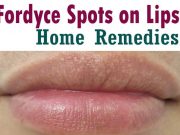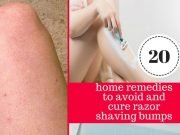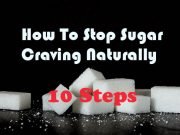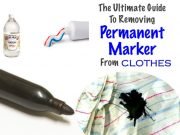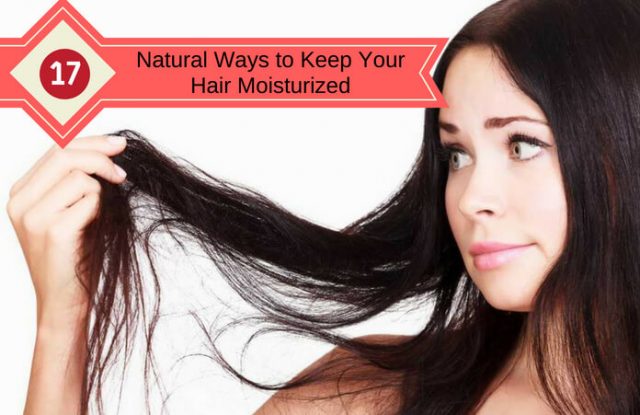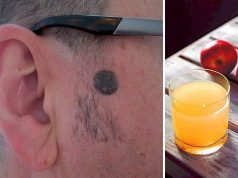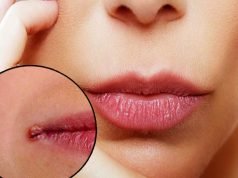Celebrities boast naturally sleek and shiny hair every day on television and magazines. In reality, however, your hair needs to be subjected to proper care for it to look glossy. Shampoos and the heat from styling products rob your hair of its natural nutrients, making it frizzy and unmanageable. This is especially true for natural hair, which needs to be regularly moisturized regularly for it to remain healthy.
Here are 17 ways to keep your hair moisturized the natural way:
1. Co-washing
Deep conditioning is a must for natural hair. While conditioning after shampooing is the general practice, you may want to try co-washing your hair with natural conditioners like avocado extracts, curd and butter. Co-washing eliminates shampooing from your routine as shampoos are harsh enough to strip your hair of its natural oils, leaving it dry and lifeless. Instead, apply the conditioner on the lengths of your hair and wrap your hair with a warm towel. Take care to wash out the conditioner from your hair thoroughly after 10 minutes. Co-washing once a week is sufficient to get visible results within a month.
2. Water
If you have natural hair, wetting your hair daily might seem like a really exhausting thing to do, but it works wonders in terms of moisturizing. Water is one of the few natural moisturizers that do not cause residual buildup on your scalp. While thoroughly wetting your hair may not be possible every day, you could always dampen it. Fill a spray bottle with water. You could add a few drops of your favorite essential oil too. Spray the mixture on your hair to cover as much of it as possible. Use a flat brush to comb through your hair.
3. Deep conditioning
Of late, celebrities with natural hair have been endorsing the L.O.C. Method, which stands for Liquid, Oil,and Cream. The idea behind this practice is to hydrate your hair with a water-based moisturizer, apply oil to retain the moisture for a longer period, and finally, apply a cream-based moisturizer to give your hair a smooth finish. Make sure that the oil and the cream you will be using are leave-in moisturizers. Comb your hair with a flat brush afterward to spread the conditioners evenly through your hair. This method should be followed no more than once a week, to prevent scalp buildup.
4. Aloe juice
The leaves of the aloe plants are as beneficial to your hair as they are to your skin. Scoop out the extracts of an aloe leaf and put them in a blender with half a cup of water and a few drops of your favorite essential oil. Store the blended mixture in a spray bottle and apply it generously to the hair ends. The mixture is generally non-sticky and is a good substitute for a leave-in conditioner. Comb your hair with a flat brush to ensure uniform application of the aloe juice through your hair length.
5. Coconut oil
Coconut oil is one of the most effective moisturizers for both your hair and skin. It is highly absorbent and is able to sink through the surface to provide hydration to the deepest layer of your hair. However, make sure that you use 100% virgin coconut oil and not a diluted substitute. Put 2 tablespoons of coconut oil into a bowl and place it on another bowl containing pre-boiled water. This melts the oil without letting the heat damage its properties. You can use it as an overnight moisturizer or even as a gel to keep flyaway strands in place.
6. Steam
Steam is an excellent way to keep hair from drying out. It can be used as a sealant after conditioning or moisturizing your hair to make sure that it stays hydrated longer. Carrier oils like almond oil, coconut oil and olive oil moisturize the hair thoroughly but they dry out within a day. Steam helps your hair retain the moisture from these oils. Immerse a clean towel in hot water. Take it out and wring it. Wrapping this hot towel around your head until it becomes cool is an equally effective homemade alternative for a steam bath at the salon.
7. Hot oil therapy
The benefits of treating your hair to hot oil therapy, at least twice a month, are plenty – it enhances the moisturizing ability of the oils, it stimulates the follicles for faster hair growth, it seals the cuticles to avoid breakage. You can use any carrier oil for this treatment along with a few drops of your preferred essential oil. To heat the oils, place them in a bowl over pre-boiled water. Once the oils have become lukewarm, massage them gently in circular motions on your scalp and the lengths of your hair. This is especially necessary during fall and winter.
8. Pre-shampoo routine
Simply shampooing and conditioning your natural hair will only aggravate its ill-health, especially if you have low porosity hair. The cuticles for low porosity hair remain closed unless heat is applied to it, which means that this kind of hair does not easily absorb moisturizers. Before shampooing your hair, divide your hair into sections and apply a generous quantity of lukewarm oil through each. Comb through each section and twist it into a braid. This helps make your beautiful natural curls more prominent after drying. Let the oils remain on your hair for at least three hours before washing them off.
9. Post-shampoo routine
After shampooing, your hair retains no moisture. Instead of a typical conditioner, you could use a hair masque for deeper conditioning and better results. You can make a hair masque at home with pre-mashed avocado, 1 tablespoon of milk and 1 tablespoon of any carrier oil of your choice. Blend the ingredients with a quarter cup of water. Apply the masque uniformly throughout your hair and keep your hair wrapped in a hot towel. Ideally, one should use clean towels with a high thread count to cause less friction between hair strands. Wash off with cool water for gorgeous hair!
10. Milk and honey
Using milk and honey to make a hair masque is one of the best gifts you could ever gift your hair. Milk is packed with proteins and fats that help nourish your hair from within. It also contains lactic acid which cleanses your scalp. Honey is an excellent lubricant and makes hair stronger. The masque is absurdly easy to make and only requires you to put a couple teaspoons of raw honey into warm milk. Pour the mixture into a spray bottle and apply it all over your hair. Let it sit for 30 minutes before rinsing it off with cool water.
11. Milk and banana
Banana is an excellent source of minerals like Potassium and Manganese. They keep your hair hydrated as well as make it healthier. Besides, this masque is a superb choice if you want to straighten your hair naturally over a period of time. Place a mashed banana along with half a cup of whole milk and a teaspoon of almond oil into a blender. The resulting mixture should have the same consistency as curd. Apply it to the strands of your hair and leave it for about 30 minutes. Rinsing your hair with cool water will help seal the ends.
12. Occasional trims
Want to know how to keep natural hair moisturized? Trimming the ends of your hair every three months will not only help you achieve that goal but also help your hair grow longer. Over time, the tips of your hair strands get splayed and cause dry or frizzy hair along with breakage and split ends. The occasional trim helps eliminate damaged ends early on, keeping the moisture in your hair sealed from within. It is also a necessary step in growing your hair out the healthy way as it stimulates the cuticles in your hair to work overtime.
13. Herb-based yogurt
Nothing suits natural hair better than plant-based ingredients. Herbs- fresh, powdered or dry- can help add moisture to dry hair as well as remedy a host of hair problems in one go. Simmer 2-3 tablespoons of castor oil on low heat and add a teaspoon of marshmallow root to the oil. Take the concoction off the heat and strain the herbs from the oil. Add shea butter to the oil and put it in the blender to achieve a thicker consistency of the mixture. It can be used as a styling gel or as a cream in the L.O.C. Method.
14. Scalp Massage
While applying oil to your hair is a vital step towards deeply moisturized hair, it is equally important to make sure that your scalp is nourished as well. Massaging your scalp at least once a week helps carry the moisture straight to the roots. It helps stimulate the hair follicles and enhances the circulation of blood in your scalp for longer, healthier hair. It also helps remove product buildup and dead skin cells. Make sure that you use your finger tips for massaging instead of your nails. The former can tear out your hair and leave scratches on your scalp.
15. Sulfate shampoos
Sulfates and parabens in shampoos are bad for all hair types. In case of natural hair, sulfates and parabens dry out your hair causing your curls to look lifeless and dull. These are the same ingredients that are used to make commercial detergents. The reason why they are put into shampoos as well is because this effectively removes oil and dirt from your hair. However, prolonged use of these shampoos disturbs the production of natural essential oils from your scalp. This makes your sebum glands overcompensate for the loss of natural oil by producing more oil than before.
16. Daily-use glycerin
Glycerin is an excellent source of moisturizer. This is why body soaps that cater to dry skin usually list glycerin as an active ingredient. It works equally well for dry hair and can be used as a daily moisturizer. Glycerin is lightweight and gentle on your hair. All you need to do is combine a quarter of a cup’s worth of glycerin with a cup of water. You may even add a few drops of your preferred essential oil, but this step is optional. Store the mixture in a spray bottle and use every day before heading out to work.
17. Nighttime routine
Natural hair requires special attention during bedtime because sleeping with your hair the way it is will make it even more unruly and cause bad tangles to form. Use a light oil like coconut oil to moisturize your hair at night. The reason why coconut oil is ideal is because it does not require you to rinse it off the next day and it also makes your hair smell nice. Use a paddle brush to comb through your hair and tie it in braids. Cover it with a silk or muslin bonnet before going to sleep to wake up with glossy curls.
Concluding remarks
Every hair is different. The only way to learn what is best for your hair is to spend time pampering it. Through trial and error, you figure out what is the best moisturizing routine for your hair, although it wouldn’t hurt to change it up a bit every few months.









